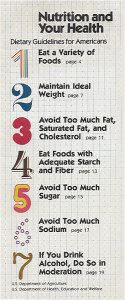This session is on Practicing Food Studies. It will be at 5;00 p.m. Details to come.
Dietary Guidelines Advisory Committee files report
Yesterday, I got a last-minute invitation to listen in on a USDA conference call announcing the release of the report of the joint USDA-DHHS Dietary Guidelines Advisory Committee (see www.dietaryguidelines.gov).
The call was remarkable for how little information it produced. It was scheduled for half an hour, but started 12 minutes late. Officials used most of the time to talk about how the committee was appointed, how the committee process worked, how transparent everything was, and how staff of USDA’s new Evidence-Based Nutrition Library (NEL) provided much of the research basis for the guidelines. This left hardly any time for asking questions, and only five got asked.
From what I heard, the committee report says pretty much what previous accounts said it would (see my post on this). If my notes on the call are correct, the committee report will recommend:
- Maintain appropriate body weight through diet and physical activity
- Shift to a more plant-based diet
- Eat more seafood; eat more low-fat dairy products; limit meat intake
- Eat less solid fats; eat less of added sugars
- Reduce sodium; eat fewer refined grains
- Follow physical activity guidelines
Is this news? Isn’t this always what the dietary guidelines say? Here, just for fun, are the first set of guidelines that came out in 1980.
The main difference seems to be the way the evidence was judged and in some of the details: the target for saturated fat is 7% and for sodium a gradual reduction to 1500 mg/day.
If so, that’s a lot of trouble to go through to get to basically the same place. I summarized that place in What to Eat as “Eat less, move more, eat plenty of fruits and vegetables, and don’t eat too much junk food.” Michael Pollen did it even more succinctly: “Eat food. Mostly plants. Not too much.”
So why would two federal agencies and 13 committee members go to all this trouble?
The quick answer is that the agencies have to. Congress says they have to review the guidelines every five years.
The longer answer, which I discuss in Food Politics and What to Eat, is that every word of the dietary guidelines is fraught with politics.
According to Food Chemical News (June 14),
The document is frequently the source of much controversy in the food industry because of the way it is used to promote certain ingredients and eating habits…Observers expect some controversy this year over recommendations made with regard to salt, a subject discussed frequently in committee meetings, as well a possible suggestion to replace two servings of grain with two servings of vegetables.
Another controversy is brewing in regards to the information on which the report was based. On Friday, the American Meat Institute, the National Cattleman’s Beef Association, the Grocery Manufacturer’s Association and the Grain Foods Foundation were among 23 groups that asked USDA and HHS to provide access to the Nutrition Evidence Library, which contains all the research used by the Dietary Guidelines committee when making their recommendations. “Without access to the data from which the DGAC drew its conclusions and recommendations, the public may not be able to provide meaningful comments,” the letter states.
Right. And now let’s see what the agencies do with this report (here’s the USDA press release on what happens next and how to comment). This report is, after all, merely advisory. Now, the real politics begins!
Additions:
Here is all the information about the Advisory Committee’s report, and the report itself (but why didn’t they put it in one easy pdf file?).
And here is USA Today’s take on it: “Panel: obesity is century’s greatest public health threat.”
Further addition, June 16: Thanks to Daniel Green (Cornell) for putting the report together in one enormous (19MB) file.

